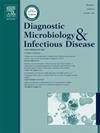MALDI-TOF MS profiling to predict resistance or biofilm production in gram-positive ESKAPE pathogens from healthcare-associated infections
IF 2.1
4区 医学
Q3 INFECTIOUS DISEASES
Diagnostic microbiology and infectious disease
Pub Date : 2024-10-14
DOI:10.1016/j.diagmicrobio.2024.116562
引用次数: 0
Abstract
Antimicrobial resistance and biofilm production in healthcare-associated infections is a health issue worldwide. This study aimed to identify potential biomarker peaks for resistance or biofilm production in ESKAPE pathogens using matrix-assisted laser desorption/ionization time-of-flight mass spectrometry (MALDI-TOF MS). Antimicrobial susceptibility and biofilm production were assessed on selected isolates. Biomarker peaks were identified using MALDI Biotyper and ClinProTools software. Among resistant strains, 90.0 % were carbapenem-resistant Acinetobacter baumannii (CRAB), 39.0 % were methicillin-resistant Staphylococcus aureus (MRSA), 17.98 % were multidrug-resistant (MDR) Pseudomonas aeruginosa, 21.6 % were vancomycinresistant Enterococcus (VRE), and 2.55 % were carbapenem-resistant Enterobacterales (CRE). Biofilm production was 40.0 % in VRE and 45.8 % in MRSA. Although no potential biomarker peaks for biofilm production were detected, several potential biomarker peaks for drug resistance in VRE (n=5), MRSA (n=4), and MDR P. aeruginosa (n=4) were detected, suggesting avenues for the development of rapid diagnostic tools.
用 MALDI-TOF MS 图谱预测医疗相关感染中革兰氏阳性 ESKAPE 病原体的抗药性或生物膜生成。
医疗相关感染中的抗菌药耐药性和生物膜产生是一个全球性的健康问题。本研究旨在利用基质辅助激光解吸电离飞行时间质谱法(MALDI-TOF MS)鉴定 ESKAPE 病原体耐药性或生物膜产生的潜在生物标志物峰。对部分分离菌株的抗菌药敏感性和生物膜生成情况进行了评估。使用 MALDI Biotyper 和 ClinProTools 软件识别生物标记峰。耐药菌株中,90.0%为耐碳青霉烯类鲍曼不动杆菌(CRAB),39.0%为耐甲氧西林金黄色葡萄球菌(MRSA),17.98%为耐多药铜绿假单胞菌(MDR),21.6%为耐万古霉素肠球菌(VRE),2.55%为耐碳青霉烯类肠球菌(CRE)。生物膜产生率在 VRE 中为 40.0%,在 MRSA 中为 45.8%。虽然没有检测到生物膜产生的潜在生物标志物峰值,但在 VRE(5 个)、MRSA(4 个)和 MDR 铜绿假单胞菌(4 个)中检测到了几个潜在的耐药性生物标志物峰值,这为开发快速诊断工具提供了途径。
本文章由计算机程序翻译,如有差异,请以英文原文为准。
求助全文
约1分钟内获得全文
求助全文
来源期刊
CiteScore
5.30
自引率
3.40%
发文量
149
审稿时长
56 days
期刊介绍:
Diagnostic Microbiology and Infectious Disease keeps you informed of the latest developments in clinical microbiology and the diagnosis and treatment of infectious diseases. Packed with rigorously peer-reviewed articles and studies in bacteriology, immunology, immunoserology, infectious diseases, mycology, parasitology, and virology, the journal examines new procedures, unusual cases, controversial issues, and important new literature. Diagnostic Microbiology and Infectious Disease distinguished independent editorial board, consisting of experts from many medical specialties, ensures you extensive and authoritative coverage.

 求助内容:
求助内容: 应助结果提醒方式:
应助结果提醒方式:


